This was a first for me – Red-tailed Hawks preying on ducklings.
1/3200, f/7.1, ISO 640, Canon 7D Mark II, Canon EF 500mm f/4L IS II USM + EF 1.4 III Extender, not baited, set up or called in
Two days ago I was watching a Red-tailed Hawk nest in northern Utah that I’ve been keeping an eye on since early spring (from a respectful distance of course and I was in my pickup on a road). There are three chicks in the nest and the parent I believe to be the adult female was in the nest and feeding bits of what appeared to be a rabbit to a couple of the youngsters when her mate landed on a distant rock. I thought he might have more prey for the chicks so I kept my eye on him and actually had my lens on him when he took off toward the nest.
Immediately after liftoff I could see that he did have prey and it wasn’t long before I was fairly confident that the prey…
1/3200, f/7.1, ISO 640, Canon 7D Mark II, Canon EF 500mm f/4L IS II USM + EF 1.4 III Extender, not baited, set up or called in
was a duckling. There are several nearby places where ducks are found and red-tails are known to take birds of a variety of species and sizes when opportunity presents itself, even though this is one of the first times I’ve seen a red-tail with any kind of bird as prey. In my experience their prey has almost invariably been small rodents, the occasional small rabbit or a snake.
1/3200, f/7.1, ISO 640, Canon 7D Mark II, Canon EF 500mm f/4L IS II USM + EF 1.4 III Extender, not baited, set up or called in
It was obvious from the get-go that he was headed toward the nest to feed his youngsters and since I was already in that general area I had quite a few opportunities to photograph him in flight. Naturally I screwed some of them up (soft, clipped body parts etc.) but even though he was far away at the beginning I laid on my shutter button because a duckling as prey was so interesting to me.
1/3200, f/7.1, ISO 640, Canon 7D Mark II, Canon EF 500mm f/4L IS II USM + EF 1.4 III Extender, not baited, set up or called in
When he got significantly closer I did get a little better detail.
1/3200, f/7.1, ISO 640, Canon 7D Mark II, Canon EF 500mm f/4L IS II USM + EF 1.4 III Extender, not baited, set up or called in
His angle of approach increased as he approached the nest and he began to call out to his family, apparently to announce his impending arrival with breakfast.
1/1600, f/7.1, ISO 640, Canon 7D Mark II, Canon EF 500mm f/4L IS II USM + EF 1.4 III Extender, not baited, set up or called in
Here he’s about to land on the nest where three chicks and his mate await him (one of the youngsters is hidden behind the female on the back left). The oldest, most independent chick is the one on the right – that bird feeds independently but the female is in the process of tearing off bits of rabbit (I think it was rabbit) and feeding them to the two younger siblings.
This nest setting is difficult for photography because it’s quite contrasty with shadows and light and the hawks and the rocks are quite similar in color so they can be hard to distinguish from each other. But it does illustrate how cryptic the birds are on the nest and that’s a good thing for them. I can attest to the fact that they’re quite difficult to spot unless you know where to look.
1/2000, f/7.1, ISO 640, Canon 7D Mark II, Canon EF 500mm f/4L IS II USM + EF 1.4 III Extender, not baited, set up or called in
I had to laugh when the adult male put his independent and greedy oldest chick through its paces. That youngster almost immediately grabbed on to the duckling and tried to pull it away but the adult was intent on making him/her work for it and wouldn’t let it go for the longest time. He didn’t try to pull it away from the chick but he wouldn’t let go of it either so his right leg became extremely stretched out in the process.
Eventually the youngster got the duckling and after picking off a few pieces to make it smaller was able to swallow most of it whole . It was a struggle to get it down though.
After all the excitement of the other RTH chicks being blown off their nest in another location (regular readers know what I’m referring to) it’s such a relief to spend some time with these birds and their nest in a safer location. I’ve had all the Red-tailed Hawk drama I can take for a while.
And I promise my subject tomorrow will be a different species…
Ron
By the way, I’m almost positive there was already another duckling in the nest before this one was delivered. Perhaps these birds have become duckling specialists during the nesting season.
Note: It’s possible I have the sexes of the two adult birds reversed – at this point I’m not sure…


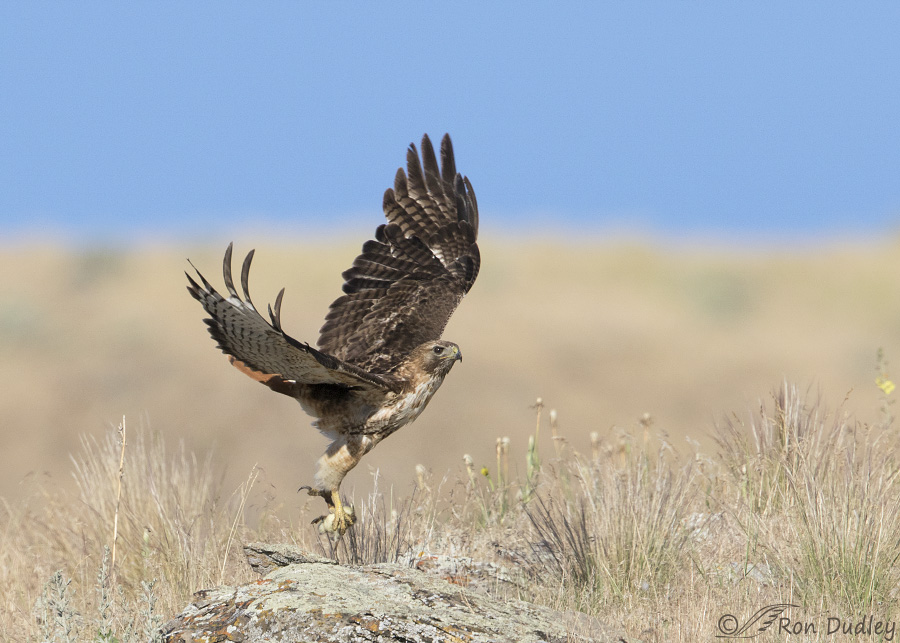
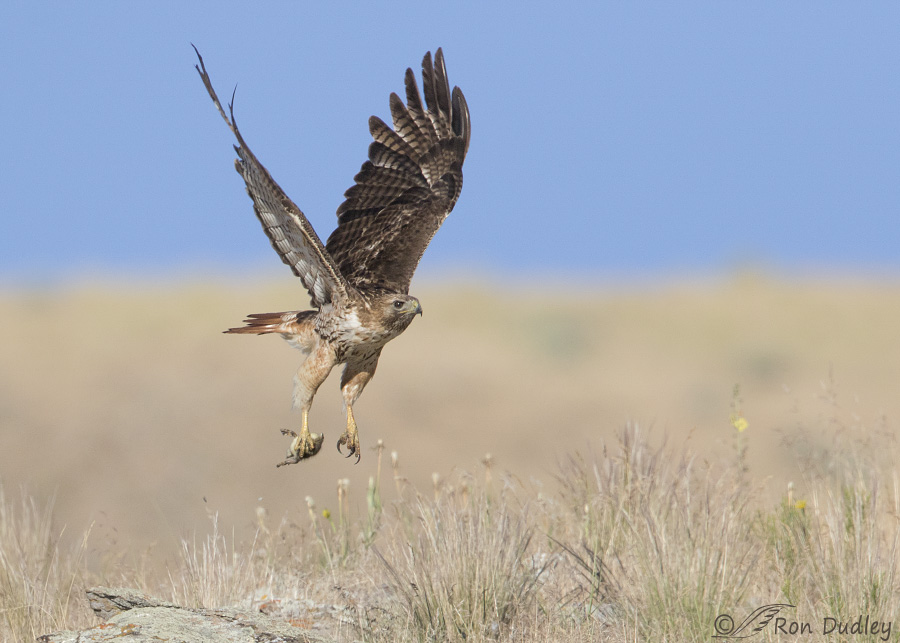
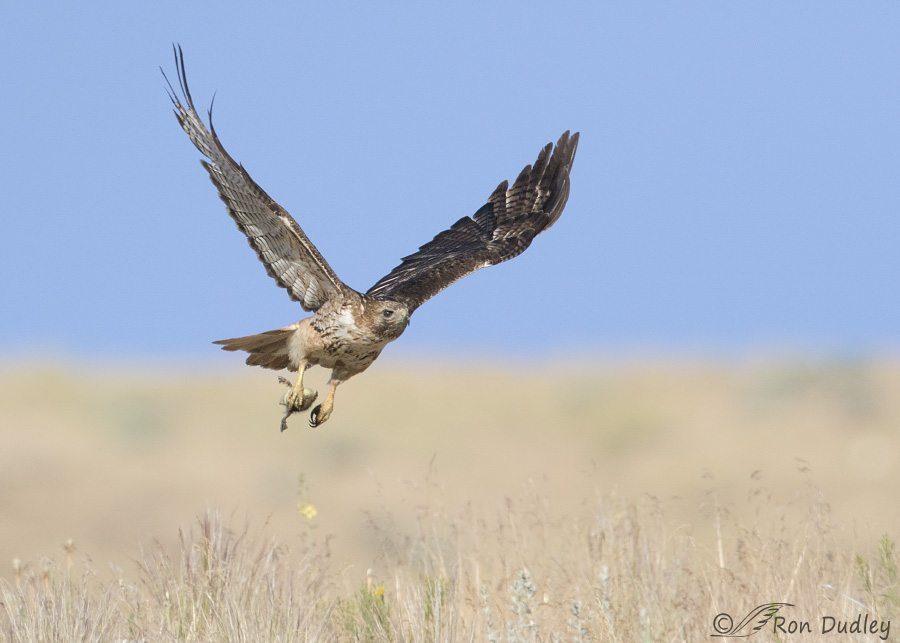
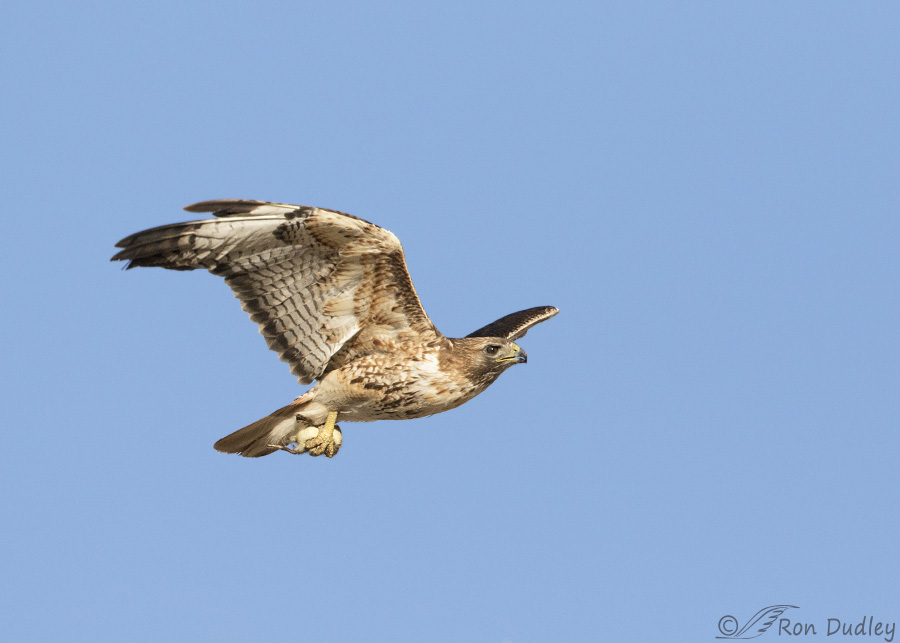
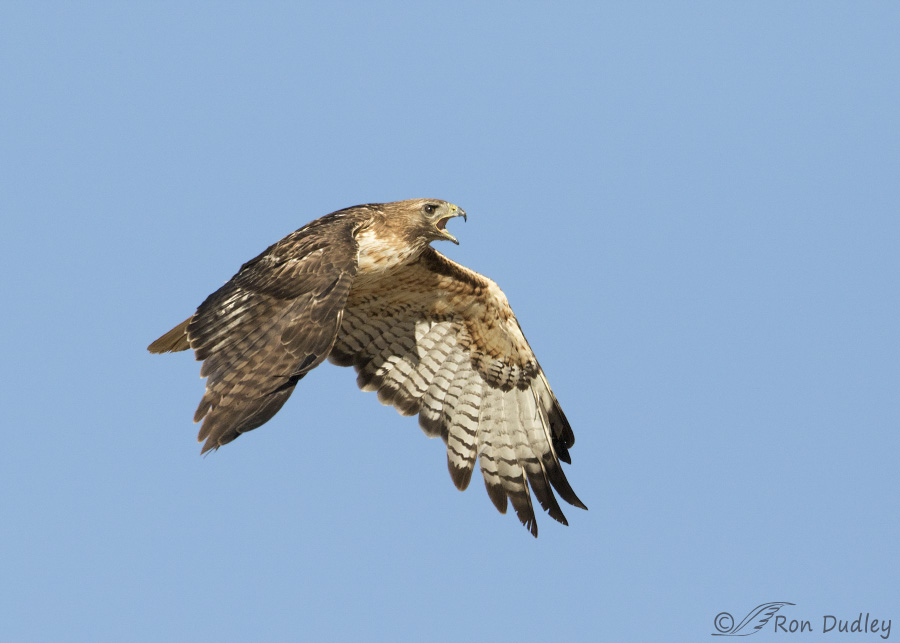
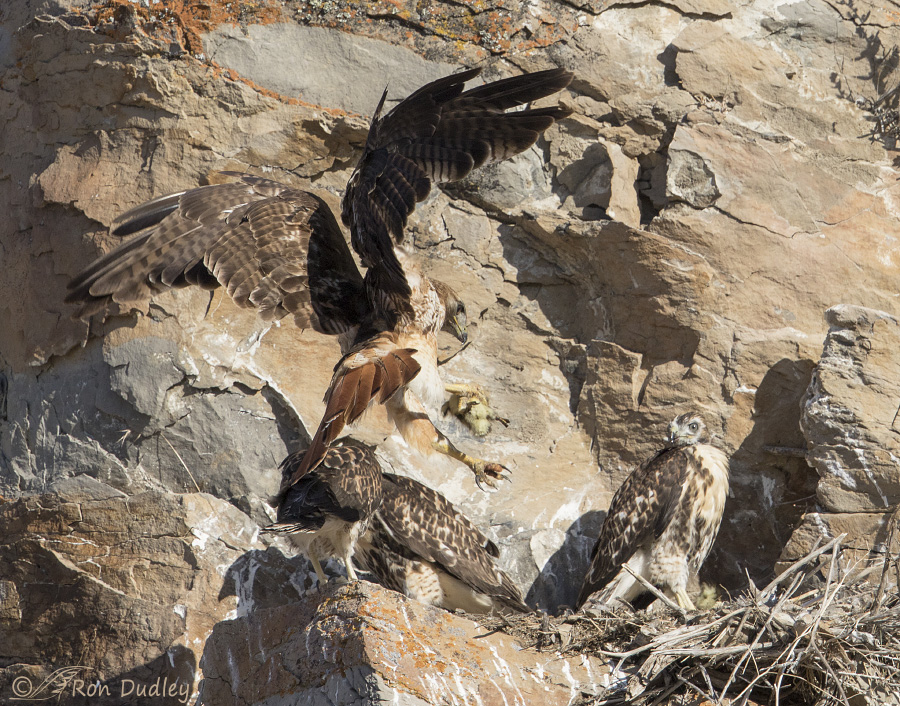
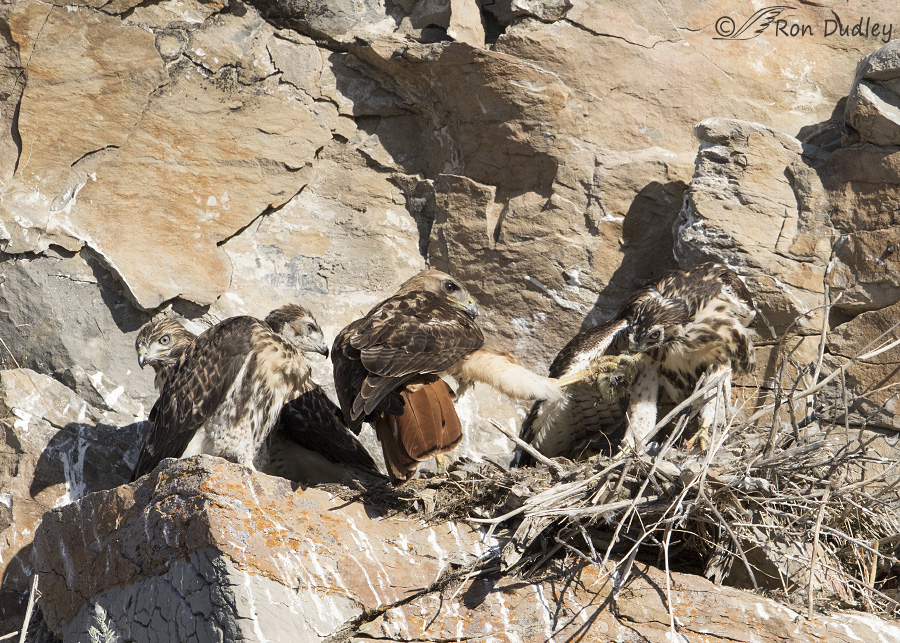
I noticed the adult in the nest feeding has a light colored eye. I’m wondering if it’s a one or two year old bird. Does it have a red tail?
Yes, Carol. Both adults have a red tail.
Love this hawk family … even if I do feel a little tug for that poor little duckling. Hawks gotta eat. Thanks for showing us how they’re doing on their rocky perch. And all those colors & textures are wonderful.
Fantastic shots!! I agree with EC about the “honey I’m home” call!! Superb photos! When I was a kid, we had a hummingbird nest in the backyard in a crepe myrtle tree (which has only bloomed once in 35 too-cool years Berkeley) – only one chick survived; the other was squashed into the side of the nest, a skeleton, when the nest was taken down long after the hummers were gone…
Sheesh, that’s quite a story, Nicole. Glad it’s not a regular occurrence!
What a find ! I very much prefer this Rocky ledge to trees with branches… and that’s not first ducky he’s been robbing .. I see yellow in nest … it’s been doom and gloom for my birds !!!!! The wind destroyed one osprey nest … I’ve been trying to get DOW to get a platform up there.. but not going to happen. .. plus another family has me in tears .. the ospreys built a nest in coop tower …. was taken down.. so they built on on power pole near by .. excel took it down… than they built they’re 3 rd nest on a bare tree overhanging a private lake I was overjoyed .. well not to be… owners were totally inconsiderate .. they mowed right under tree they jetskiied right next to it .. had a wild gratuatiin party with tons of teenagers and jet boats.. neighbors said it was real loud !!! Ospreys had eggs .. I asked the owners if they could give the birds some space .. they said .. lots of trees around they can go build somewhere else .. needless to say the ospreys abandoned they’re eggs…. been super depressed IDIOTS!!!!!!
I am so sorry. That is awful, awful, awful news. Some of the oxygen thieves in our species make me ballistic with rage.
Damn, that’s awful, Marina. “Idiots” is absolutely right!
And yes, there was already a duckling in the nest when this second one was brought in.
GRRRRRR!!! Marina, that’s exactly why I wanted to be AWAY from humans in this move! We’re (collectively) so darn arrogant…as if we’re the only critter on this spinning rock. GRUMBLE!
Another fascinating series.
Love that ‘honey I am home’ shot.
And learning that the smaller, weaker chicks are still getting the support they need.
Thank you, EC.
Your understanding of behavior is great and I always learn something. The Photography is spectacular. I learned something from the grounds keepers at the golf course last week. Pelicans come into town often and they told me they saw them eating ducklings. That was a new one for me. I thought pelicans only ate fish. I never get tired of what you post. Thanks.
Thank you, Betty. Pelicans (of either species) eating ducklings is a new one on me. I thought Brown Pelicans only ate fish and a few marine invertebrates and American White Pelicans only ate fish and the occasional amphibian and crayfish.
Many, many years ago, Mariah taught me never to say, “Redtails can’t do that.” They’ll prove you wrong every time, just for fun. Then, there’s my favorite quote from “Hawks in Flight” where either one of Sibley, Dunne or Sutton wrote, “Any furred, feathered, or scaled creature that is smaller than a groundhog and turns its back on a meal-minded Red-tailed is very likely going to be returned to the earth as a pellet.” My bet (only a quarter…I’m a penny-ante gambler) is on Dunne, but who knows? And I’ll quibble with the “smaller than a groundhog” part. Mariah honed her skills on mallards and pheasants in Wyoming. She hasn’t yet caught a duckling, but that’s because she hasn’t been out hunting when the ducklings are out and about. Her human is prohibited from doing that…harrumph! 🙂
Laura, I love that quote, accurate or not…
This is a terrific series, Ron. Lots of interesting behavior going on here. Any guess as to the age of each chick?
Thanks, Dennis. If I ventured a guess that’s all it would be so I won’t throw one out there. Since I can’t even see the chicks in the nest for the first few weeks after hatching it’s very difficult for me to tell.
Spectacular shots! The hawk’s “pose” in the landing shot is particularly striking. You really nailed that one! 🙂 I also like the last shot — had no idea the parents played tug of war with the youngsters. It makes perfect sense, though. I know it happens, but I’m still pretty shocked at how fast the chicks have grown and matured.
I do have a little pang for the duckling and its parents. :*(
Marty, You should have seen that older chick this morning! In two days it looks like it has matured a week or more. It was actually out of the nest and exploring the clifftop.
Now, about your pang for the ducks – would that be a sympathy pang or a hunger pang?…
Mine would be a hunger pang 😉 Ducks is good eatin’ if hawk caught and cooked properly (NOT over-cooked)!
My vegetarian (tribal slang fot the idiot who can’t hunt) self is having sympathy pangs – while acknowledging the necessity for the red-tails and their family.
Sympathy. The duckling is too little — not enough meat to make it worthwhile. 😉
Beautiful and educational photos! As yooosh 🙂 The 2nd one is particularly eye-catching… love the way the vegetation looks… it sketches in the environment without taking away from the bird.
Good point about that second image, Joanne.
Wonderful images. Love the views of their perfect camouflage on the nest.
Thank you, Dan.
I love that you get to see these wonderful behaviors. And that you can follow these nests (or lack thereof, referring to the fallen one). What you post is interesting enough that I don’t need you to change species – I like what I learn about birds from you.
Thanks so much for those kind words, Susan.
Coyotes, foxes, wolves, eagles, large fish, turtles, bullfrogs, now red-tailed hawks and, occassionaly, even vultures , all take ducklings…I sometimes wonder that there are any adult waterfowl!!!
Yes, so it’s ironic that waterfowl are generally some of our most abundant birds!
Ducklings must be yummy, everything seems to eat them. I have seen, gulls, crows, pelicans and even a huge carp eat them. It always reminds me of the the children’s song. 5 baby ducks went out to play over the hill and far away, mama duck called quack quack come back and only 4 little ducks came back……
April, I think part of it is that ducklings are relatively defenseless – part of the reason ducks and geese have so many chicks (to insure that at least a few of them survive). I liked your song!
Truly awesome behavioral series Ron!
Charlotte
Thanks, Charlotte.
Oh I forgot to add, it looks like this MIGHT be the female bringing in the duckling to me. If the tarsus looks more like the size of a AA battery, it’s more likely to be a female. If the tarsus looks more like a pencil, a male.
Laura, In retrospect I’m now sure you’re right and it’s the female. I’ve reversed them here. Hate it when I do that – really hate it!!!
Great shots, Ron even if I cringe a bit at the duckling being taken………… Opportunistic feeders when there are many mouths to feed for sure. It’s always interesting what birds do to start preparing their young for independence.:)
Judy, speaking of “many mouths to feed” this morning I watched a Burrowing Owl pair trying to keep nine youngsters fed and happy. An enormous job!
WOW! Didn’t realize they could have that many! Last year our GHO’s had 3 and that was plenty!
These are some great shots Ron. Didn’t know Red-tails preyed on ducks either, but certainly if the opportunity presents itself I can understand. Still, I had always figured they were primarily mammal predators. Love the fact your posts are so educational!!
They are “primarily mammal predators”, Dick – but they’re opportunistic feeders too. Thank you for mentioning the educational aspect of my blog.